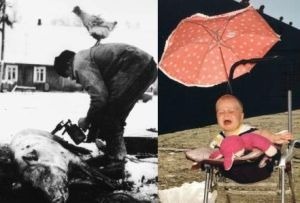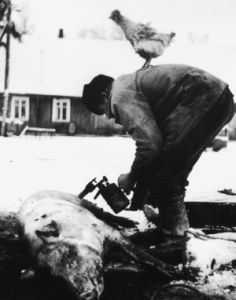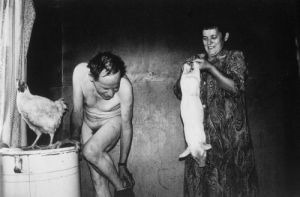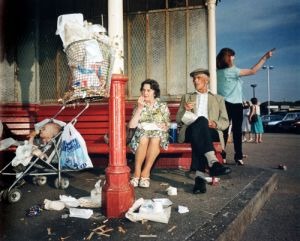RESERVED SLAUGHTER 0
(Exhibition of photographs of R.Vikšraitis and M.Parr “The Real World”)Milda Kiaušaitė
www.kamane.lt , 2010 10 04
In brief: Lithuania and Great Britain, Kaunas Photography Gallery and Kaunas Architects‘ House, art photographers Rimaldas Vikšraitis and Martin Parr – these are not accidental combinations of words but a roadway towards the real world. The exhibition “The Real World” is a joint project of two art photographers who have matured in different cultures and social layers.
R.Vikšraitis and M.Parr are related not only by the documentary social photography. Both authors created the cycles exhibited at Kaunas galleries in the second half of the 20th century; they both were discovered in the prestigious Arles Festival. True, the talent of the guest from Britain was recognised in France back in 1986, while many critics believed even in 2006 that R. Vikšraitis’ photographs would never receive recognition of the public and people of culture.
R.Vikšraitis. "The Real World"
Looking at photographs of R. Vikšraitis, the viewer feels like participating in a pig slaughter described by Sigitas Parulskis in the essay “Killing”. The return to the village, to one’s roots and the dirt present there, which may not be washed by any detergents from hands and heart, leave a trace in the sub-conscience. Looking at photographs of R.Vikšraitis we realise that we do not want to see what is shown to us and to accept the dark reality. Lithuanians close their eyes.
M.Parr. "The Real World"
Meanwhile, Martin Parr titled the chronicler of our century opens his eyes widely. Perhaps he is far from our culture, and pains of the Lithuanian nation are strange to him. Still, the photographer offered R.Vikšraitis for the “Discovery of the Year” award in Arles Festival in 2009. And now the joint exhibition of the two artists leaves no doubts about the value of works of R. Vikšraitis.
The authors photograph and analyse life very differently. M. Parr looks around Great Britain (series “The Last Visit” , “Price of Life”), and peeks at various cultures of the world curiously allocating special attention to the tourist’s attitude and image, analysing the stereotype of a cosmopolite who feels at home everywhere (“Small World”). Meanwhile, R. Vikšraitis makes circles in his native village and watches the fall of people without feeling disgust or moralising them (“Grimaces of the Weary Village”, “Stories of a Homestead”).
R.Vikšraitis “Grimaces of the Weary Village”, 1998
The photographs of M. Parr play with the viewer, do not hide anything but do not throw ugly things to the face. The world pictured by him is beautiful, tempting with food, things and trips, it is not angry, it promises something.
M.Parr "The Last Visit", 1985
The direct and frank look, central composition prevails in the black-and-white photographs of R. Vikšraitis as well as in the brightly-coloured photographs of M. Parr. Things are everywhere: things which form our life, which are used or which we carry with ourselves. People pictured by both photographs crave for things. They may lose each other, the relation, virtues and dignity; still, things do not let us confuse them with anybody else; they help us to realise the heroes of views as people. Things become the reason for losing human nature and a pretext to remain a human being.
Despite the differences of photographs of R. Vikšraitis and M. Parr, people pictured in them do not understand that they have been chosen to represent a cliché, a stereotype of the society. The accelerated process of materialisation has been captured in photographs of both artists.













